哨兵是一个分布式系统,你可以在一个架构中运行多个哨兵进程,这些进程使用流言协议来接收关于Master主服务器是否下线的信息,并使用投票协议来决定是否执行自动故障迁移,以及选择哪个Slave作为新的Master。
一、哨兵模式概述
1.1、为什么要启动哨兵模式
当我们的主服务器宕机后,要手动的去切换主从模式,这样的人工干预,费事费力,还会造成一段时间我们的服务不能使用。所有我们要使用哨兵模式来解决这一问题。
1.2、什么是哨兵模式
哨兵是对Redis的系统的运行情况的监控,它是一个独立进程,功能有二个:
监控主机Redis和从机Redis是否运行正常;
主机Redis出现故障后自动将从机转化为主机;
1.3、哨兵工作原理
单个哨兵的工作原理:
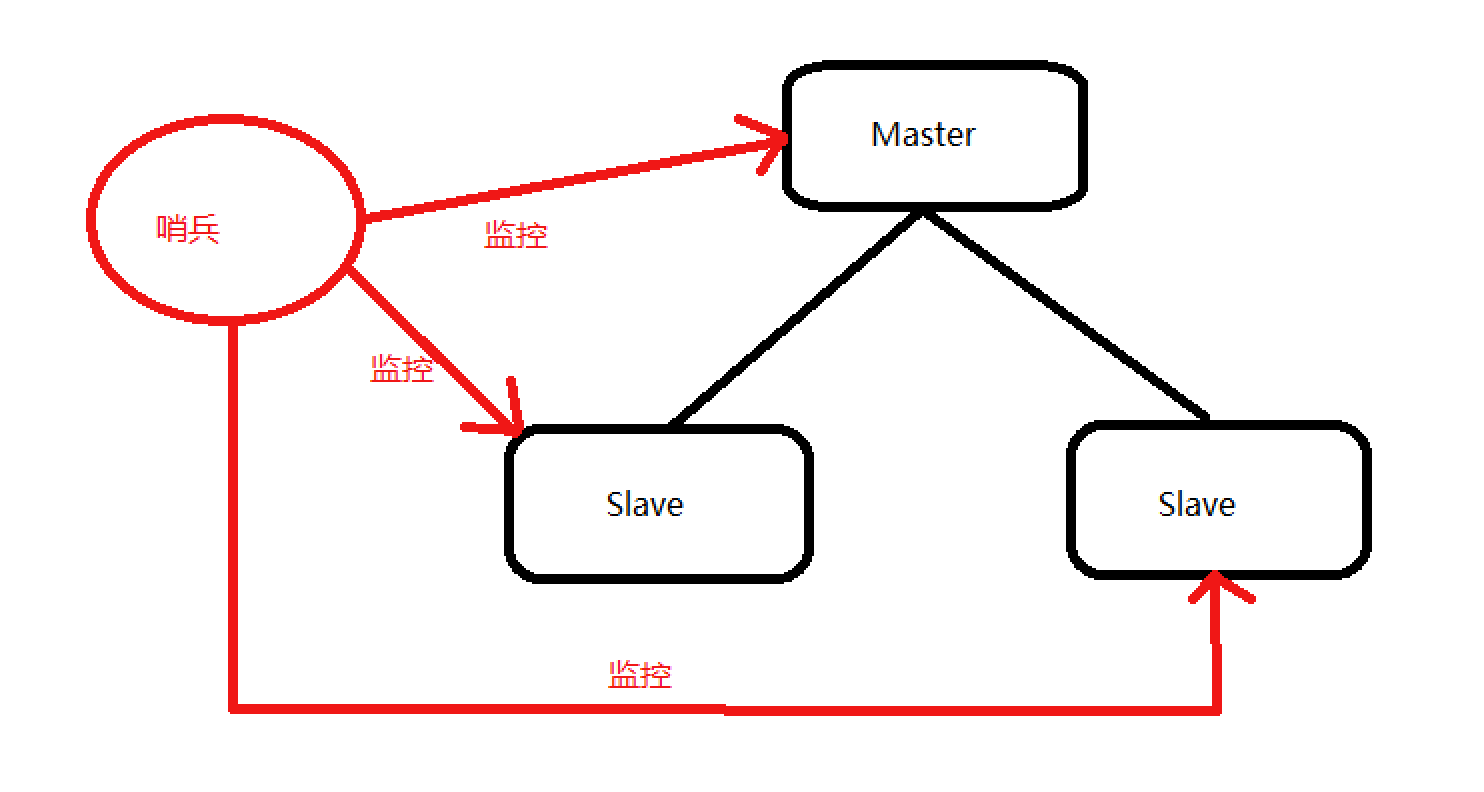
单个哨兵,只需要监控主Redis,就可能得到从Redis。
多个哨兵的工作原理:
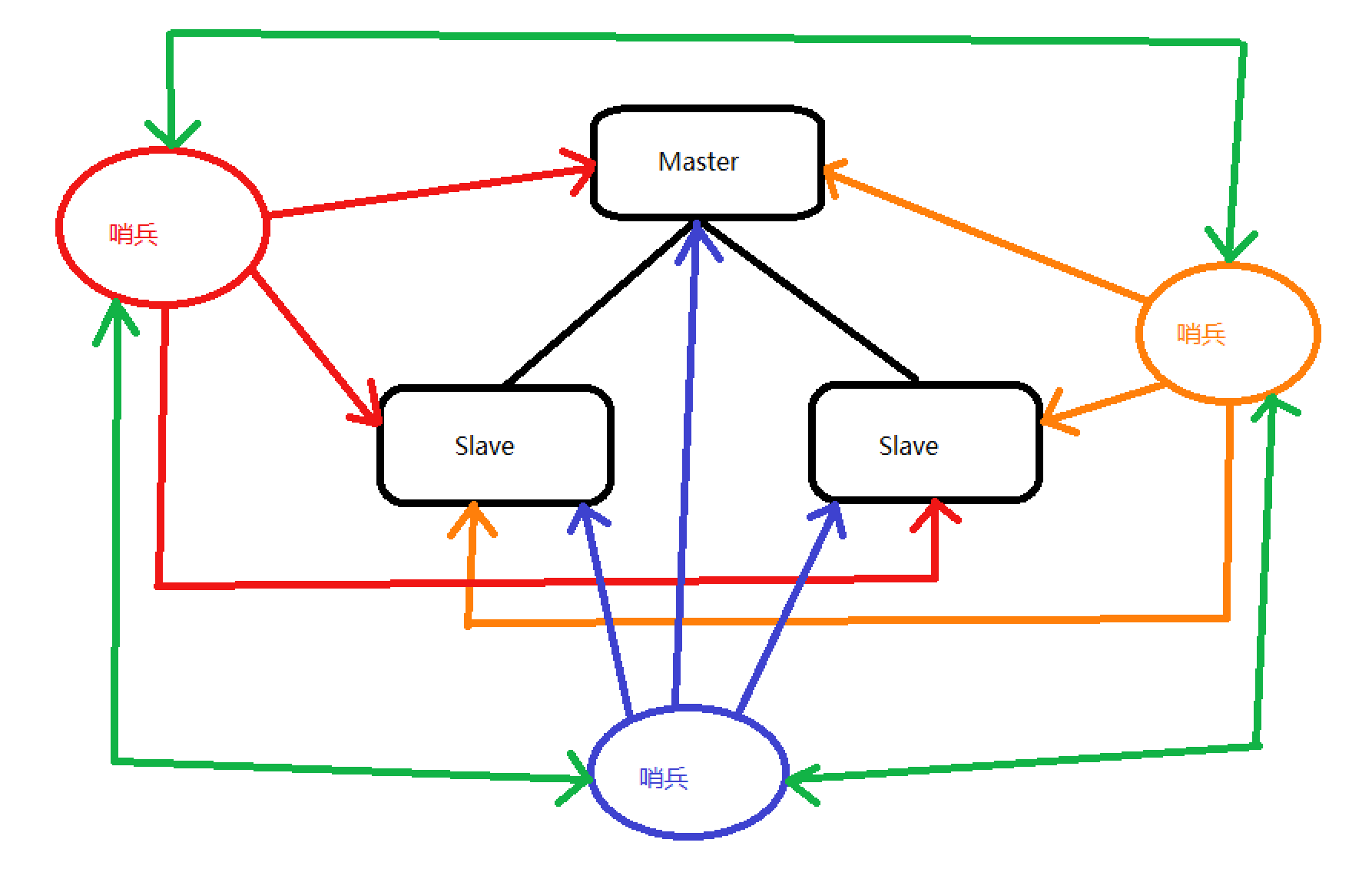
多个哨兵,不仅同时监控主从Redis,而且哨兵之间互为监控。
多个哨兵,防止哨兵单点故障。
1.4、哨兵功能
集群监控:负责监控主从集群中的Master和Slave进程是否正常工作。
故障转移(failover):如果Master宕机,会自动从Slave中选举出新的Master,进行主从自动切换。
配置中心:如果发生了故障转移,Sentinel负责通知客户端新的Master的地址。
消息通知:如果某个redis节点有故障,那么Sentsinel会发送报警消息给系统管理员。
1.5、配置说明
protected-mode no
#关闭保护模式,使外网能访问。
port 26379
#修改端口。三份文件分别不同。
daemonize no
#修改为后台运行。
pidfile /var/run/redis-sentinel.pid
#指定不同pid文件,注意文件夹不存在自己要新建。
logfile ""
#配置哨兵日志文件。
dir "/tmp"
#配置哨兵工作路径。
sentinel monitor mymaster 127.0.0.1 6379 2
#配置哨兵需要监控的主节点ip和端口,2表示哨兵数(quorum)
sentinel auth-pass mymaster 123
#配置哨兵连接主节点的认证密码。(主节点配置的requirepass)。
sentinel down-after-milliseconds mymaster 5000
#配置多少毫秒后没收到主节点的反馈,则主观认为主节点down了。
sentinel failover-timeout mymaster 30000
#表示如果30秒后,mysater仍没活过来,则启动failover,从剩下的slave中选一个升级为master
sentinel parallel-syncs mymaster 1
#parallel-syncs 指定了在执行故障转移时, 最多可以有多少个slave同时对新的master进行同步, 这个数字越小, 完成故障转移所需的时间就越长
注意:
majority表示大多数哨兵
quorum表示哨兵数
如果quorum < majority,比如5个哨兵,majority就是3,quorum设置为2,那么就3个哨兵授权就可以执行切换。
但是如果quorum >= majority,那么必须quorum数量的哨兵都授权,比如5个哨兵,quorum是5,那么必须5个哨兵都同意授权,才能执行切换。
二、单哨兵模式
在一主多从的环境中,125为主机,123、124为从机
哨兵主机121
2.1、设置哨兵
修改配置文件/usr/local/redis/etc/sentinel.conf
[root@zuolaoshi /]# cp /usr/local/src/redis-6.2.14/sentinel.conf /usr/local/redis/etc/sentinel.conf
[root@zuolaoshi /]# cd /usr/local/redis/etc/
[root@zuolaoshi etc]# vim sentinel.conf
#修改配置
sentinel monitor mymaster 192.168.1.123 6379 1
注意:
mymaster:监控主数据的名称,命名时可以使用大小写字母和“.-_”符号
192.168.1.123 6379:主机的IP和端口号
2.2、启动哨兵
[root@zuolaoshi redis]# ./bin/redis-sentinel ./etc/sentinel.conf
或
[root@zuolaoshi redis]# ./bin/redis-server ./etc/sentinel.conf --sentinel
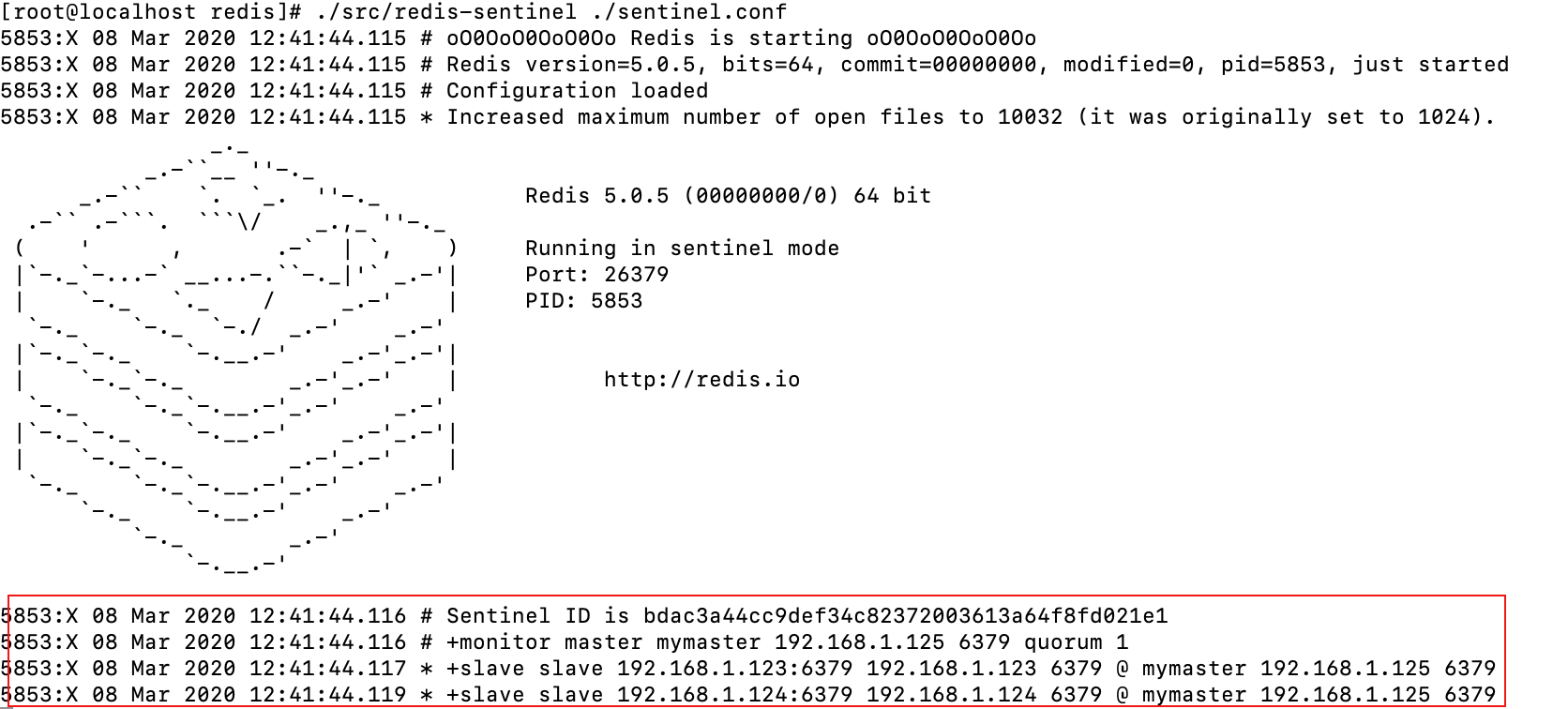
看出:
125为主机,123、124为从机
2.3、从机宕机
杀死124从机进程,30秒后观察哨兵日志
[root@zuolaoshi redis]# ps -ef|grep redis
root 18752 12399 0 06:35 pts/1 00:00:00 ./bin/redis-cli
root 22163 1 0 12:18 ? 00:00:02 ./bin/redis-server 0.0.0.0:6379
root 22392 22002 0 12:44 pts/2 00:00:00 grep --color=auto redis
[root@zuolaoshi redis]# kill -s 9 22163

启动124从机,观察哨兵日志
[root@zuolaoshi redis]# ./bin/redis-server ./etc/redis.conf

2.4、主机宕机
杀死125主机进程,30秒后观察哨兵日志
[root@zuolaoshi redis]# ps -ef|grep redis
root 14988 1 0 06:20 ? 00:01:15 ./bin/redis-server 0.0.0.0:6379
root 15144 8874 0 06:35 pts/0 00:00:00 ./bin/redis-cli
root 18527 18104 0 12:50 pts/1 00:00:00 grep --color=auto redis
[root@zuolaoshi redis]# kill -s 9 14988
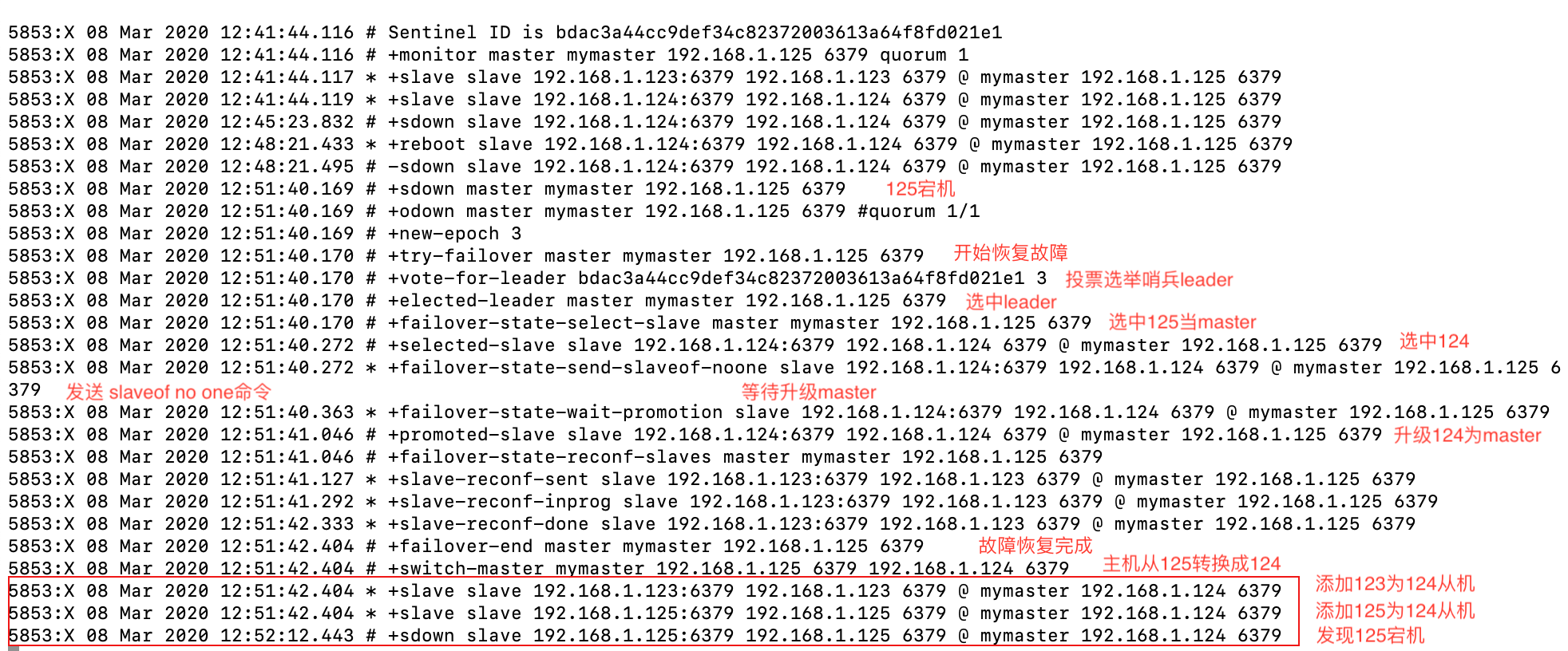
日志状态说明:
+reset-master:
#主服务器已被重置。
+slave:
#一个新的从服务器已经被 Sentinel 识别并关联。
+failover-state-reconf-slaves:
#故障转移状态切换到了 reconf-slaves 状态。
+failover-detected:
#另一个 Sentinel 开始了一次故障转移操作,或者一个从服务器转换成了主服务器。
+slave-reconf-sent:
#领头(leader)的 Sentinel 向实例发送了 [SLAVEOF](/commands/slaveof.html) 命令,为实例设置新的主服务器。
+slave-reconf-inprog:
#实例正在将自己设置为指定主服务器的从服务器,但相应的同步过程仍未完成。
+slave-reconf-done:
#从服务器已经成功完成对新主服务器的同步。
-dup-sentinel:
#对给定主服务器进行监视的一个或多个 Sentinel 已经因为重复出现而被移除 —— 当 Sentinel 实例重启的时候,就会出现这种情况。
+sentinel:
#一个监视给定主服务器的新 Sentinel 已经被识别并添加。
+sdown:
#给定的实例现在处于主观下线状态。
-sdown:
#给定的实例已经不再处于主观下线状态。
+odown:
#给定的实例现在处于客观下线状态。
-odown:
#给定的实例已经不再处于客观下线状态。
+new-epoch:
#当前的纪元(epoch)已经被更新。
+try-failover:
#一个新的故障迁移操作正在执行中,等待被大多数 Sentinel 选中(waiting to be elected by the majority)。
+elected-leader:
#赢得指定纪元的选举,可以进行故障迁移操作了。
+failover-state-select-slave:
#故障转移操作现在处于 select-slave 状态 —— Sentinel 正在寻找可以升级为主服务器的从服务器。
no-good-slave:
#Sentinel 操作未能找到适合进行升级的从服务器。Sentinel 会在一段时间之后再次尝试寻找合适的从服务器来进行升级,又或者直接放弃执行故障转移操作。
selected-slave:
#Sentinel 顺利找到适合进行升级的从服务器。
failover-state-send-slaveof-noone:
#Sentinel 正在将指定的从服务器升级为主服务器,等待升级功能完成。
failover-end-for-timeout:
#故障转移因为超时而中止,不过最终所有从服务器都会开始复制新的主服务器(slaves will eventually be configured to replicate with the new master anyway)。
failover-end:
#故障转移操作顺利完成。所有从服务器都开始复制新的主服务器了。
+switch-master
#配置变更,主服务器的 IP 和地址已经改变。 这是绝大多数外部用户都关心的信息。
+tilt:
#进入 tilt 模式。
-tilt:
#退出 tilt 模式
启动125主机,观察哨兵日志
[root@zuolaoshi redis]# ./bin/redis-server ./etc/redis.conf
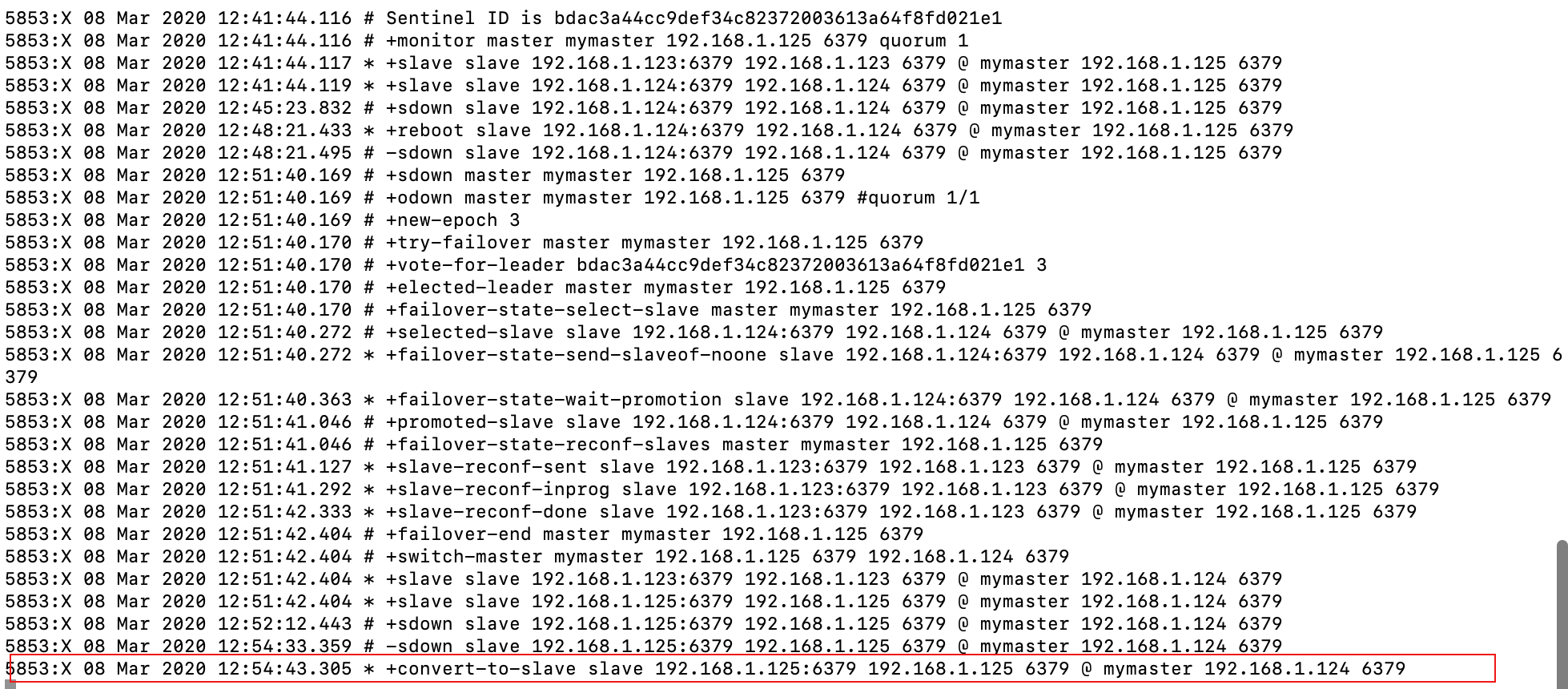
您可以使用以下命令测试哨兵连接。
redis-cli -p 26379 sentinel masters
该命令会返回所有主节点的信息。如果哨兵工作正常,您将看到类似以下的输出:
1) 1) "name"
2) "mymaster"
3) "ip"
4) "192.168.1.123"
5) "port"
6) "6379"
7) "runid"
8) "12345678901234567890abcdef1234567890"
9) "flags"
10) "master"
要通过哨兵获取当前的主节点地址,可以使用以下命令:
redis-cli -p 26379 sentinel get-master-addr-by-name mymaster
1) "192.168.1.123"
2) "6379"
三、多哨兵模式

在一主多从的环境中,123为主机,124、125为从机
121中设置三个哨兵sentinel-1.conf、sentinel-2.conf、sentinel-3.conf
3.1、设置哨兵
将哨兵文件sentinel.conf,复制三份sentinel-1.conf、sentinel-2.conf、sentinel-3.conf
[root@zuolaoshi /]# cd /usr/local/redis/etc/
[root@zuolaoshi etc]# cp sentinel.conf sentinel-1.conf
[root@zuolaoshi etc]# cp sentinel.conf sentinel-2.conf
[root@zuolaoshi etc]# cp sentinel.conf sentinel-3.conf
修改配置文件/usr/local/redis/etc/sentinel-1.conf
[root@zuolaoshi etc]# vim sentine-l.conf
#修改配置
protected-mode no
port 27001
daemonize yes
pidfile "/var/run/redis-sentinel-27001.pid"
logfile "/usr/local/redis/log/27001.log"
sentinel monitor mymaster 192.168.1.123 6379 2
修改配置文件/usr/local/redis/etc/sentinel-2.conf
[root@zuolaoshi etc]# vim sentine-2.conf
#修改配置
protected-mode no
port 27002
daemonize yes
pidfile "/var/run/redis-sentinel-27002.pid"
logfile "/usr/local/redis/log/27002.log"
sentinel monitor mymaster 192.168.1.123 6379 2
修改配置文件/usr/local/redis/etc/sentinel-3.conf
[root@zuolaoshi etc]# vim sentine-3.conf
#修改配置
protected-mode no
port 27003
daemonize yes
pidfile "/var/run/redis-sentinel-27003.pid"
logfile "/usr/local/redis/log/27003.log"
sentinel monitor mymaster 192.168.1.123 6379 2
3.2、启动哨兵
[root@zuolaoshi /]# cd /usr/local/redis
[root@zuolaoshi redis]# ./bin/redis-sentinel ./etc/sentinel-1.conf
[root@zuolaoshi redis]# ./bin/redis-sentinel ./etc/sentinel-2.conf
[root@zuolaoshi redis]# ./bin/redis-sentinel ./etc/sentinel-3.conf
3.3、从机宕机
杀死125从机进程
[root@zuolaoshi redis]# ps -ef|grep redis
root 20733 1 0 11:55 ? 00:00:00 ./src/redis-server 0.0.0.0:6379
root 20775 20646 0 11:59 pts/0 00:00:00 grep --color=auto redis
[root@zuolaoshi redis]# kill -s 9 20733
启动125从机
[root@zuolaoshi redis]# ./bin/redis-server ./etc/redis.conf
3.4、主机宕机
杀死123主机进程,30秒后观察哨兵日志
[root@zuolaoshi redis]# ps -ef|grep redis
root 27555 1 0 11:55 ? 00:00:01 ./bin/redis-server 0.0.0.0:6379
root 27693 27393 0 12:08 pts/0 00:00:00 grep --color=auto redis
[root@zuolaoshi redis]# kill -s 9 27555
启动123主机
[root@zuolaoshi redis]# ./bin/redis-server ./etc/redis.conf
一主两从多机配置文件修改
环境准备:
-
192.168.8.11 redis主节点 redis、sentinel
-
192.168.8.12 redis从节点 redis、sentinel
-
192.168.8.13 redis从节点 redis、sentinel
主节点修改配置文件:
vim /etc/redis/redis.conf
bind 0.0.0.0
protected no # 关闭加密保护 否则从节点无法连接
daemonize yes # 开启后台模式将no改为yes
timeout 300 # 连接超时时间
port 6379 # 端口号
logfile "/usr/local/redis/logs/redis.log" # 存放日志
pidfile /usr/local/redis/redis.pid # 定义pid文件
dbfilename dump.rdb
dir /usr/local/redis/data # 存放在安装目录下的data目录下 用于存放数据(目录需要提前创建)
save 3600 1
save 300 100
save 60 10000 # snapshot触发的时机
stop-writes-on-bgsave-error yes # 当snapshot时出现错误无法继续时,阻塞客户端“变更操作”,“错误”可能因为磁盘已满/磁盘故障/OS级别异常等
rdbcompression yes # 启用rdb文件压缩,默认为“yes”,压缩往往意味着“额外的cpu消耗”,同时也意味这较小的文件尺寸以及较短的网络传输时间
appendonly yes # 开启aof功能,只有在“yes”下,aof重写/文件同步等特性才会生效
修改从节点配置文件:
vim /etc/redis/redis.conf
replicaof 192.168.8.11 6379 ##添加 master IP和端口(注意:老版本的redis是搜索 slaveof 有些许区别)
启动测试
测试:
##-->master节点操作
/etc/init.d/redis restart
127.0.0.1:6379> ping
PONG
127.0.0.1:6379> set name jack
OK
127.0.0.1:6379> get name
"jack"
##查看连接状态
127.0.0.1:6379> info replication
# Replication
role:master
connected_slaves:2 ##两个从节点
slave0:ip=192.168.8.12,port=6379,state=online,offset=6535,lag=0
slave1:ip=192.168.8.13,port=6379,state=online,offset=6535,lag=0
##-->从节点操作
/etc/init.d/redis restart
127.0.0.1:6379> ping
PONG
127.0.0.1:6379> get name
"jack"
##查看连接状态
127.0.0.1:6379> info replication
# Replication
role:slave
master_host:192.168.8.11
master_port:6379
master_link_status:up
一主两从搭建成功,下面开始配置三哨兵
# 配置文件修改
vim /usr/local/redis/sentinel.conf
protected-mode no
daemonize yes
logfile "/usr/local/redis/logs/sentinel.log"
sentinel monitor mymaster 192.168.8.11 6379 2 # 监控的主节点信息 “2”表示有两个sentinel认为主节点主观下线,则将主机点判断为客观下线
sentinel down-after-milliseconds mymaster 30000 # 30s后主机点无反应,则判断为主观下线
sentinel failover-timeout mymaster 180000
# 将配置文件发送到另外两台服务器
scp /usr/local/redis/sentinel.conf 192.168.8.12:/usr/local/redis/
scp /usr/local/redis/sentinel.conf 192.168.8.13:/usr/local/redis/
# 启动测试
cd /usr/local/redis/
##--启动哨兵(三台机器均启动)
redis-sentinel sentinel.conf
##--动态查看
tail -f /usr/local/redis/logs/sentinel.log
##主节点
redis-cli
127.0.0.1:6379> info replication
# Replication
role:master
connected_slaves:2
slave0:ip=192.168.8.13,port=6379,state=online,offset=684083,lag=1
slave1:ip=192.168.8.12,port=6379,state=online,offset=684226,lag=0
##--停止主节点redis
[root@redis-master redis]# netstat -tnlp
Active Internet connections (only servers)
Proto Recv-Q Send-Q Local Address Foreign Address State PID/Program name
tcp 0 0 0.0.0.0:6379 0.0.0.0:* LISTEN 7544/./src/redis-se
tcp 0 0 0.0.0.0:26379 0.0.0.0:* LISTEN 7479/./src/redis-se
tcp 0 0 0.0.0.0:22 0.0.0.0:* LISTEN 961/sshd
tcp 0 0 127.0.0.1:25 0.0.0.0:* LISTEN 1204/master
tcp6 0 0 :::26379 :::* LISTEN 7479/./src/redis-se
tcp6 0 0 :::22 :::* LISTEN 961/sshd
tcp6 0 0 ::1:25 :::* LISTEN 1204/master
[root@redis-master redis]# kill 7544
##--新的主节点机器
redis-cli
127.0.0.1:6379> info replication
# Replication
role:master
connected_slaves:1
slave0:ip=192.168.8.12,port=6379,state=online,offset=743594,lag=1
##已实现故障转移
##--启动故障机器
/etc/init.d/redis restart
redis-cli
127.0.0.1:6379> info replication
# Replication
role:slave
master_host:192.168.8.13
master_port:6379
master_link_status:up
# 恢复的机器会自动加入集群降为从节点